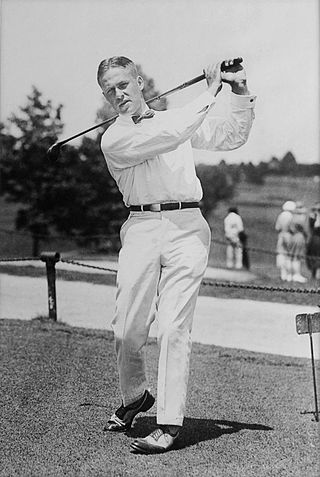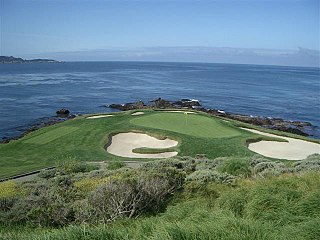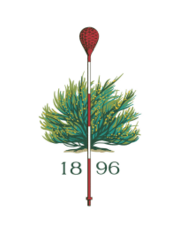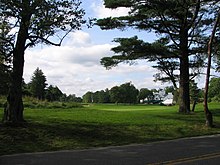The United States Open Championship, commonly known as the U.S. Open, is the annual open national championship of golf in the United States. It is the third of the four major championships in golf, and is on the official schedule of both the PGA Tour and the European Tour. Since 1898 the competition has been 72 holes of stroke play, with the winner being the player with the lowest total number of strokes. It is staged by the United States Golf Association (USGA) in mid-June, scheduled so that, if there are no weather delays, the final round is played on the third Sunday. The U.S. Open is staged at a variety of courses, set up in such a way that scoring is very difficult, with a premium placed on accurate driving. As of 2022, the U.S. Open awards a $17.5 million purse, the largest of all four major championships.

Jack William Nicklaus, nicknamed The Golden Bear, is a retired American professional golfer and golf course designer. He is widely considered to be either one of or the greatest golfer of all time. He won 117 professional tournaments in his career. Over a quarter-century, he won a record 18 major championships, three more than second-placed Tiger Woods. Nicklaus focused on the major championships—the Masters Tournament, U.S. Open, Open Championship and PGA Championship—and played a selective schedule of regular PGA Tour events. He competed in 164 major tournaments, more than any other player, and finished with 73 PGA Tour victories, third behind Sam Snead (82) and Woods (82).

Robert Tyre Jones Jr. was an American amateur golfer who was one of the most influential figures in the history of the sport; he was also a lawyer by profession. Jones founded and helped design the Augusta National Golf Club, and co-founded the Masters Tournament. The innovations that he introduced at the Masters have been copied by virtually every professional golf tournament in the world.

Torrey Pines Golf Course is a 36-hole municipal golf facility on the west coast of the United States, owned by the city of San Diego, California. It sits on the coastal cliffs overlooking the Pacific Ocean in the community of La Jolla, just south of Torrey Pines State Reserve. Opened in 1957, it was built on the site of Camp Callan, a U.S. Army installation during World War II.

The men's major golf championships, commonly known as the major championships, and often referred to simply as the majors, are the most prestigious tournaments in golf. Historically, the national open and amateur championships of Great Britain and the United States were regarded as the majors. With the rise of professional golf in the middle of the twentieth century, the majors came to refer to the most prestigious professional tournaments.

Pebble Beach Golf Links is a public golf course on the west coast of the United States, located in Pebble Beach, California.

Oakmont Country Club is a country club in the eastern United States, located mostly in Plum with only a very small portion of the property located in Oakmont, suburbs of Pittsburgh in western Pennsylvania. Established 120 years ago in 1903, its golf course is regarded as the "oldest top-ranked golf course in the United States." It was designated a National Historic Landmark in 1987. The Pennsylvania Turnpike separates seven holes (2–8) from the rest of the course.
The following is a partial timeline of the history of golf.

Oakland Hills Country Club is a private golf club in the central United States, located in Bloomfield Township, Michigan, a suburb northwest of Detroit. It consists of two 18-hole courses designed by Donald Ross: the South Course (1918) and the North Course (1923).

Cherry Hills Country Club is a private country club in the western United States, located in Cherry Hills Village, Colorado, a suburb south of Denver.
Canterbury Golf Club is a private golf and country club located in the Cleveland suburb of Beachwood, Ohio, US. The club was formerly the home of the DAP Championship, part of the Web.com Tour Finals.

The 1993 U.S. Open was the 93rd U.S. Open, held June 17–20 at Baltusrol Golf Club in Springfield, New Jersey, west of New York City. Lee Janzen shot all four rounds in the 60s and tied the U.S. Open scoring record to win the first of his two U.S. Open titles, two strokes ahead of runner-up Payne Stewart.
The 1981 U.S. Open was the 81st U.S. Open, held June 18–21 at the East Course of Merion Golf Club in Ardmore, Pennsylvania, a suburb northwest of Philadelphia. David Graham won his second major title and became the first Australian to win the U.S. Open, three strokes ahead of runners-up George Burns and Bill Rogers.
The 1971 U.S. Open was the 71st U.S. Open, held June 17–21 at the East Course of Merion Golf Club in Ardmore, Pennsylvania, a suburb west of Philadelphia. Lee Trevino, the 1968 champion, won his second U.S. Open, defeating Jack Nicklaus by three strokes in an 18-hole playoff. It was the second of Trevino's six major titles and the second of four times in which Nicklaus was the runner-up to Trevino in a major; Nicklaus won his third U.S. Open the following year.
The 1968 U.S. Open was the 68th U.S. Open, held June 13–16 at the East Course of Oak Hill Country Club in Rochester, New York. Lee Trevino equaled the tournament scoring record and won the first of his six major titles, four strokes ahead of runner-up Jack Nicklaus. It was also the first win on the PGA Tour for Trevino, age 28.
The 1967 U.S. Open was the 67th U.S. Open, held June 15–18 at Baltusrol Golf Club in Springfield, New Jersey, west of New York City. Jack Nicklaus shot a final round 65 and established a new U.S. Open record of 275, four strokes ahead of runner-up Arnold Palmer, the 1960 champion. It was the second of Nicklaus' four U.S. Open titles and the seventh of his eighteen major championships.
The 1966 U.S. Open was the 66th U.S. Open, held June 16–20 at the Lake Course of the Olympic Club in San Francisco, California. Billy Casper, the 1959 champion, staged one of the greatest comebacks in history by erasing a seven-stroke deficit on the final nine holes to tie Arnold Palmer; he then prevailed in an 18-hole playoff to win the second of his three major titles. It was the fourth playoff in five years at the U.S. Open, and the third for Palmer, the 1960 champion.
The 1950 U.S. Open was the 50th U.S. Open, held June 8–11 at the East Course of Merion Golf Club in Ardmore, Pennsylvania, a suburb northwest of Philadelphia. In what became known as the "Miracle at Merion," 1948 champion Ben Hogan won the second of his four U.S. Open titles in an 18-hole playoff over 1946 champion Lloyd Mangrum and George Fazio, just 16 months after being severely injured in an automobile accident. It was the fourth of Hogan's nine major titles.
The 1926 U.S. Open was the 30th U.S. Open, held July 8–10 at Scioto Country Club in Columbus, Ohio. Noted amateur Bobby Jones, winner of the British Open two weeks earlier, won the second of his four U.S. Opens, one stroke ahead of runner-up Joe Turnesa.
















